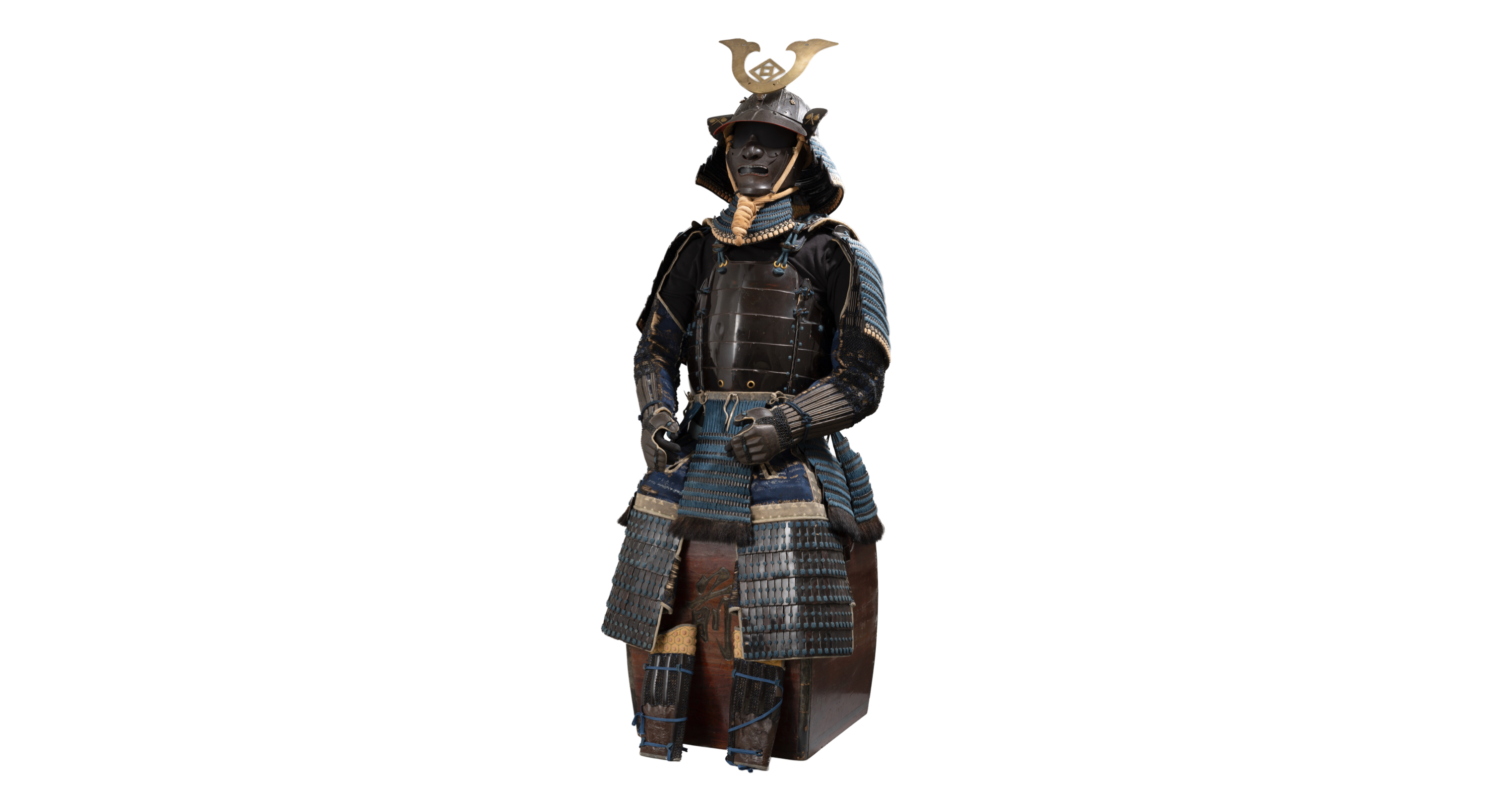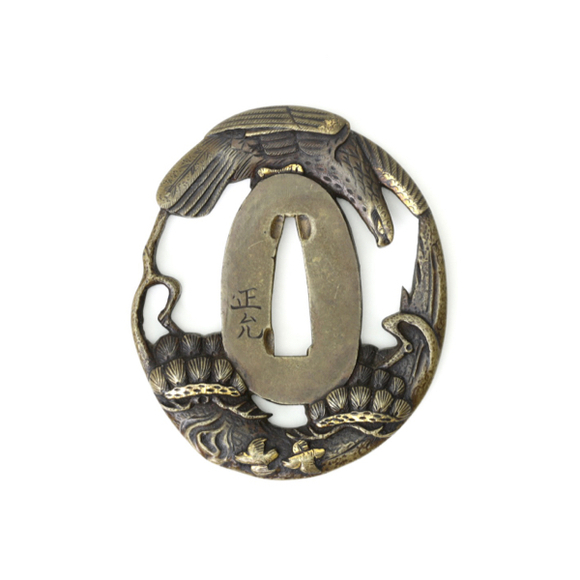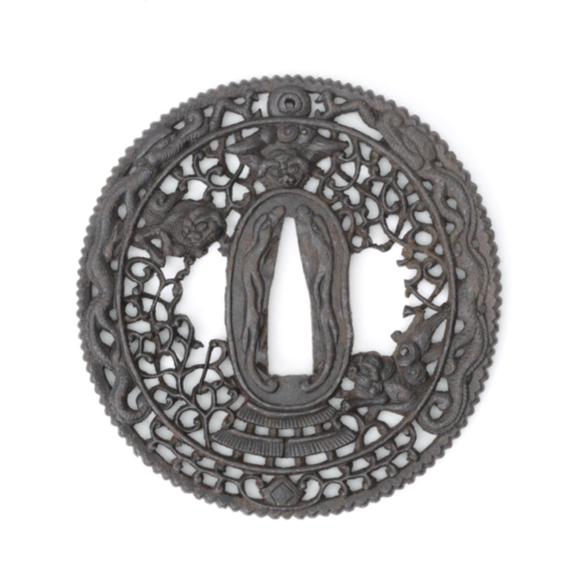Russet iron, one-piece construction with decorative grooves.

Japan
Iron, steel, copper, brass, gold, urushi lacquer, buffalo horn, boar's hair, silk
Dō 10.5 kg
Helmet 2.2 kg
Other parts 5.9 kg
Total 18.6 kg
Box 6.5 kg
17th century
Textile may be later but with signs of being worn
Imported from Japan
A European dealer
Description
A fine set of samurai armor, dating from the 17th century. It consists of scales and plates, laced together with kon-ito-odoshi: deep indigo blue lacing.

Dō (胴); "cuirass"
The core is a heavy steel dō with overlapping segments and a center ridge at the front to deflect incoming weapons sideways. It has four dents in the breastplate, and one on each side; test shots by a musket to ensure it was bulletproof. After passing the tests it was lacquered over with dark reddish brown lacquer.

Plain, heavy, bulletproof dō like this are typical for the early Edo up until around the Kanbun (寛文) period of 1661-1673. Samurai around this time still expected to see action and so their armors were fully functional.
From the late 17th century onwards, the focus shifted more towards ornamental armors. On some late armors, the test shots were simulated.
From the dō hang seven kusazuri (草摺) or faulds, suspended by indigo-dyed straps. Their fringes are finished with boar's hair, the boar being a revered animal for its courage and aggression towards hunters and its tenaciousness even when being severely wounded.

Haidate (佩楯); "apron"
Below that is worn a haidate (佩楯) with black lacquered leather lamellar armor protection for the legs. The matching greaves, suneate (臑当), have plate and mail protection over indigo silk brocade.


The fine deerskin egawa bands on the front that normally fall under the kusazuri are decorated with a series of symbols that incorporate a Christian cross emerging from grass, a pattern called shobugawa.
Christianity made quite an impact in Japan in the 16th century, which is when this motif became common on armors. The religion was banned in 1637 following a major rebellion. The faith now being punishable by death; many renounced the faith while others kept practicing in secret. Those were then known as kakure kirishitan or "hidden Christians" who would leave hints of their faith here and there. See, for example, the secret Christian cross on the rooftops of Himeji Castle.

What appear to be Christian crosses on the upper part of the apron.
This motif started to appear on armors from the 16th century onwards and was perhaps inspired by Jesuit iconography.

Cover of Innocentia victrix
Printed by the Jesuit Press, Canton, China 1671.
Kabuto
The highlight of this suit are the kabuto (兜, helmet) and menpō (面頬, face mask). The helmet's dome is made of several plates, riveted together.
The outer plates have beautiful ornamental cutouts in the form of a stupa called gorintō (五輪塔) or "five-ringed tower." Their form represents the five elements that make up the Buddhist universe: earth, water, fire, wind and mu, "emptiness". Originally a structure that held religious relics, gorintō also served memorial and funerary purposes in Japan. As a symbol, the gorintō belongs to the Mikkyō (密教) or "secret teachings" of Tantric Buddhism that are found among others in Shingon, Tendai, Kegon, Hossō, and Zen.
The helmet is possibly unique, and is classified as kawari kabuto or "eccentric helmet".






Its five-tiered shikoro or neck guard is in the same style as the kusazuri and sode, again laced with the same indigo dyed cord. At the front, the two outward folded elements are called fukigaeshi, they typically carry mon, japanese family crests. In this case, the crests consist of two crossed commander's batons called saihai (采配) each. It is the kamon of the Naganuma clan.

The menpō is finished in russet iron with a red lacquered inside. It shows a menacing face with exposed teeth. There are some remains of gilding on the teeth. The nose is a separate piece that can be taken off for a more open mask.



Maedate (前立); "front crest"
On top of the helmet prides an associated maedate of kuwagata form, modeled after the horns of a stag beetle. It has a separate double square meadate on top of it. The base of the kuwagata is also engraved with a square mon, called kugi-nuki (釘抜) or "nail puller" and the character ichi (一), "one" above it.1
It was a popular mon among samurai as it symbolized a large force created by a simple tool. It was also called manryoku (万力) which literally means "strength of a thousand."2
1. The kugi-nuki mon appears in the Kenmon Shokamon (見聞諸家紋)
or “Various Observed Family Crests” of 1467–1470.
Page 21
2. Xavid "Kiho" Pretzer; O-umajirushi; A 17th-Century Compendium of Samurai Heraldry.
The Academy of the Four Directions Cambridge, MA. 2015.
Maedate are still a relatively under-studied subject but in essence, they worked as personal identifiers as well as symbols of rank and clan affiliation. Higher ranks had larger maedate. Knowing who was who on the field was very important for ensuring one's heroic deeds were noticed.



Sode (袖); "pauldrons"
The shoulders are protected by sode in the form of 7 ribbed metal plates each. They are lacquered black, and laced together with indigo straps, their form and finish matching the neck and throat guards.


Kote (籠手); "armored sleeves"
The kote (籠手), armored sleeves, are of plate and mail over indigo silk brocade. It has plated protection over the knuckles and the base of the thumb. The inside of the gauntlets is lined with fine deerskin.


Box and mannequin
The armor can be displayed on the box that fits all parts except the helmet. It has the mae (前) carved in the front panel, meaning "to advance". An often-seen mark on Japanese armor chests.
The armor comes with a museum-grade mannequin of museummannequins.com consisting of a torso, head, and arms mounted on a wooden plate that stands on top of the box. It gives the armor a little more "body" than the standard way of displaying such armor on a wooden frame.

The Naganuma Clan
The Naganuma clan is a relatively small clan that originally hailed from the north of Honshu island, in what is now Fukushima prefecture. During the Sengoku period they forged local alliances, among others with one of Japans's most powerful warlords; Date Masamune.
Masamune was positive toward Western influence, and allowed missionaries and traders into his realm. He even funded a diplomatic mission to the Pope Paul V to whom he wrote a letter. Besides Rome the expedition visited the Philippines, Mexico, Spain and Rome. Masamune had to stop his support and exploits after Tokugawa Ieyasu banned Christianity.
By the early Edo period, Naganuma Nagamasa served Lord Matsudaire Naomasa, grandson of Shogun Tokugawa Ieyasu. He resided in Izumo province, Harami province and finally in Mino province.
Naganuma Nagamasa's son, Naganuma Tansai, was a brilliant military strategist who founded Naganuma Ryu, a prestigious Edo-period school of samurai military thought. He based himself on various innovative Japanese arts, as well as study of Chinese classics like Qi Jiguangs Jixiao Xinshu and Mao Yuanyi's Wubezhi.
At age 18 already he was employed by the Naganuma Ryu with a stipend of 100 koku, 1 koku being 180 kilos of rice, or roughly the amount of rice needed to feed one person for a year. In 1656, aged 22 he opened a private school in Edo's Shiba district. Later he would serve the Arima clan, ruling over Kurume domain, for s stipend of 250 koku. After 5 years he quit after being asked to become a kunigaro or "domain elder" to Lord Matsudaira Naoaki.
He authored several works on military affairs and at some point tutored over 1000 disciples, only 10 of which received the highest level of competence and with that the right to fully transmit the discipline to their students. His methods were employed by the Owari clan of Nagoya, the Kuroda clan of Fukuoka, and also in the Tsu, Aizu and Sendai domains.
The armor probably belonged to one of the Naganuma clan members. The Christian crosses are perhaps a gentle reminder of their former alliance with Date Masamune and his support for Christianity.
References
Chris Glenn & Suguru Maruoka; Naganuma Ryu Troop Movement Training Manual: An Edo Period Samurai Military Arts and Sciences Textbook. Kindle Edition.
Condition
The indigo silk brocade on this armor still shows the signs of actual wearing by its owner, something I personally very much like to see as it tells of the life of this set. Also some damage here and there to the paper lining of the metal armor parts, and to the outer lacquer at places.
Considering the age, and the fact the item was actually used, it is in very good condition. No significant repairs other than small touchups, no replacements. Normal signs of wear and tear. See photos.

The worst lining damage is inside the dō, depicted here.

Some chips to the lacquer here and there.
Conclusion
A fine set of all-matching armor of the Edo period, made for a samurai who still expected to have to use it. They feared the muskets that now equipped all armies and doth dō and kabuto are executed in very thick steel to offer superior protection, the dō carrying the musket test marks as accolades to its protective qualities.
The fine and unusual kabuto complements this rare set of armor.



































Unusual tsuba with foreign figures and Chinese auspicious symbols.






